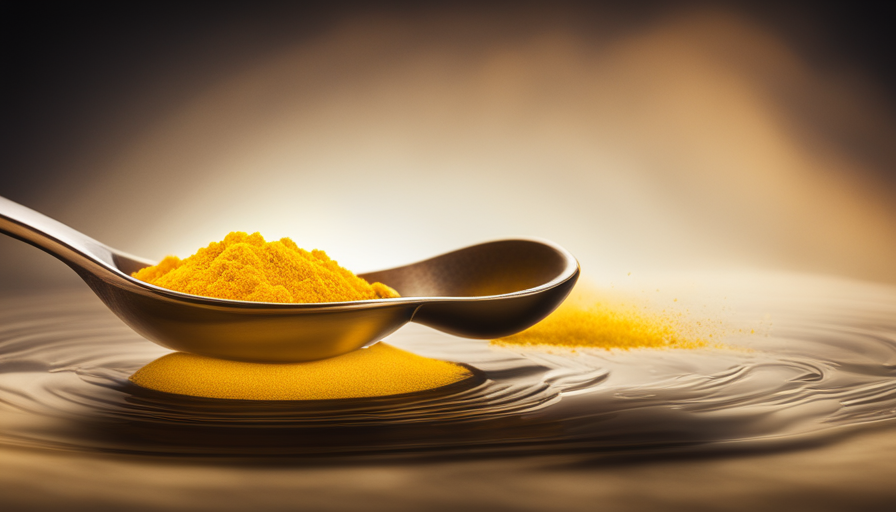A well-known saying suggests, ‘You are what you eat.’ And it’s true that what we consume can significantly affect our bodies, even influencing the color of our urine. Turmeric is one example of a food that is known to alter urine color.
Turmeric, a vibrant yellow spice commonly used in cooking and traditional medicine, contains a pigment called curcumin. This pigment is responsible for the characteristic golden hue of turmeric, and when consumed in large amounts, it can sometimes lead to a noticeable change in urine color.
But why does this happen? And is it something to be concerned about? In this article, we will delve into the science behind urine color, explore how turmeric affects urine color, discuss possible reasons for this change, and address any potential health concerns or benefits.
So, if you’ve ever wondered why your urine might look different after consuming turmeric, read on to uncover the truth behind this fascinating phenomenon.
Key Takeaways
- Turmeric’s pigment curcumin can cause a change in urine color, giving it a yellowish tinge.
- The liver metabolizes curcumin and excretes it through urine, resulting in the temporary urine color change.
- Changes in urine color due to turmeric consumption are harmless and temporary.
- Persistent or intense changes in urine color should be discussed with a healthcare professional.
The Science Behind Urine Color
Have you ever wondered why your urine color can vary so much from day to day? The color of urine can be influenced by several factors, including hydration levels and medication use.
When you are well-hydrated, your urine color tends to be a pale yellow or almost clear. This is because the kidneys are efficiently flushing out waste products, resulting in diluted urine. On the other hand, if you are dehydrated, your urine may appear more concentrated and have a darker yellow color.
Certain medications can also affect the color of your urine. For example, some antibiotics and laxatives can cause the urine to turn a bright yellow or even orange color. This is due to the presence of certain pigments in these medications that are excreted through the urine. Other medications, such as certain vitamins and minerals, can cause the urine to appear more vibrant or even fluorescent.
Now, let’s transition to the topic of turmeric’s pigment – curcumin.
Turmeric’s Pigment – Curcumin
Experience the vibrant transformation of your pee when you consume turmeric – ever wondered if it’s the secret behind that golden hue? Let’s dive into the science behind turmeric’s pigment, curcumin, and its effects on health.
Curcumin is the active compound in turmeric responsible for its distinctive yellow color. It is also known for its potent antioxidant and anti-inflammatory properties. To extract curcumin, various methods can be used, such as solvent extraction or steam distillation. Once consumed, curcumin is metabolized by the body and can be detected in urine.
Research suggests that curcumin may have several health benefits. Studies have shown its potential in reducing inflammation, improving brain function, and even preventing chronic diseases like cancer and heart disease. However, it’s important to note that most studies have been conducted in animal models or test tubes, and more research is needed to fully understand the effects of curcumin on human health.
As we explore the topic of turmeric and urine color further, it’s fascinating to consider how curcumin’s presence in the body may contribute to the changes we observe. Stay tuned for the next section, where we delve into the relationship between turmeric and urine color.
Turmeric and Urine Color
Witness the astonishing transformation in your body as the vibrant shades of gold emerge, leaving you in awe of the powerful effects of turmeric on the color of your pee. Turmeric has long been known for its potent pigment, curcumin, which is responsible for the distinctive yellow-orange hue. When consumed, curcumin is metabolized by the body and excreted through urine, resulting in a noticeable change in color.
To understand the impact of turmeric on urine color, let’s take a closer look at the science behind it. The liver plays a crucial role in metabolizing curcumin and converting it into water-soluble compounds. These compounds are then eliminated from the body through urine. As a result, the urine can acquire a yellowish tinge, sometimes even leaning towards a bright orange color.
It’s important to note that these urine color changes are harmless and temporary. They are merely a reflection of the body’s natural detoxification process. However, if you experience any other concerning symptoms alongside the color change, it’s advisable to consult a healthcare professional.
In the next section, we will explore possible reasons for urine color change, shedding light on any potential health effects.
Possible Reasons for Urine Color Change
Explore the various factors that can cause a shift in the color of your pee, allowing you to understand the potential reasons behind this intriguing phenomenon. When it comes to turmeric consumption, it’s known to have the ability to change urine color. The active compound in turmeric, called curcumin, is responsible for this effect. Curcumin can give urine a bright yellow or even orange color, which can be quite surprising for some individuals.
While a change in urine color due to turmeric consumption is generally harmless, it’s important to note that there can be other possible health implications related to urine color changes. For example, certain medical conditions like liver or kidney disease can also cause changes in urine color. This is why it’s crucial to pay attention to any drastic or persistent changes in urine color and seek medical advice if necessary.
In addition to turmeric, there are other natural remedies and foods that can also lead to changes in urine color. For instance, consuming beetroot can cause urine to turn pink or reddish. Similarly, consuming certain medications or supplements can also alter urine color.
Understanding the possible reasons behind urine color changes can help you identify any potential health concerns. In the next section, we’ll explore other factors that can affect urine color, providing you with a comprehensive understanding of this bodily function.
Other Factors that Can Affect Urine Color
Discover how various factors, such as hydration levels, certain medications, and even your diet, can influence the color of your pee. Medications and urine color can be related in some cases. Certain medications, like certain antibiotics or laxatives, can cause changes in urine color. For example, some antibiotics can turn urine a bright yellow or even orange color. Additionally, medications that contain dyes or pigments, such as some antipsychotic drugs, can also affect urine color.
Another factor that can impact urine color is dehydration. When you’re dehydrated, your body doesn’t have enough water to flush out waste products, which can lead to concentrated urine. This concentrated urine can appear darker in color, often a deep yellow or amber.
It’s important to note that changes in urine color due to medications or dehydration are usually harmless and temporary. However, if you notice persistent changes in urine color or experience other symptoms, it’s always best to consult with a healthcare professional.
Understanding how medications and dehydration can affect urine color is just the beginning. In the next section, we’ll explore the potential health concerns or benefits associated with changes in urine color.
Potential Health Concerns or Benefits
Experiencing shifts in urine color can serve as a valuable indicator of potential health issues or advantageous wellness outcomes. When it comes to turmeric consumption, it’s important to consider the potential side effects and benefits it may have on urine color.
Scientific research suggests that turmeric can cause a temporary change in urine color, turning it into a bright yellow or even orange hue. This is due to a compound called curcumin, which is responsible for turmeric’s vibrant color.
To further understand the implications of this color change, it’s crucial to consult scientific studies. One study published in the Journal of Medicinal Food found that consuming turmeric extract caused a significant increase in urinary excretion of curcumin metabolites. Another study conducted by the Department of Physiology at the University of California, Davis, discovered that the yellow pigment in turmeric, known as urothione, could be detected in the urine after ingestion.
However, it’s important to note that while turmeric may cause a temporary change in urine color, it’s generally considered safe for consumption. If you notice a sudden and persistent change in urine color after consuming turmeric or any other substance, it’s advisable to consult a healthcare professional to rule out any potential health concerns.
Transitioning into the subsequent section about managing urine color change, it’s important to be aware of tips for maintaining optimal urine color.
Tips for Managing Urine Color Change
To manage any shifts in the color of your urine, try implementing these tips for maintaining optimal urinary health.
First and foremost, managing hydration is key. Make sure to drink enough water throughout the day to keep your urine diluted and flowing smoothly. This can help prevent concentration of any pigments that may be causing the color change.
Additionally, certain dietary adjustments can also be helpful. Avoid foods and drinks that are known to cause urine discoloration, such as beets or certain medications. Incorporate foods and drinks that promote urinary health, like cranberry juice or green tea.
It’s important to note that if you’re experiencing persistent or concerning changes in urine color, it’s best to consult with a healthcare professional for further evaluation.
With these tips in mind, you can manage any shifts in urine color while taking turmeric. If you’re looking to explore other ways to incorporate turmeric into your wellness routine, continue reading the next section.
Other Ways to Incorporate Turmeric
If you’re looking for alternative ways to incorporate turmeric into your routine, there are plenty of options to explore. Besides adding turmeric to your meals, there are various turmeric recipes and turmeric supplements available that can help you reap the benefits of this vibrant spice.
One way to incorporate turmeric into your diet is by trying out different turmeric recipes. You can find a wide range of recipes online that feature turmeric as a key ingredient. From golden milk to turmeric-spiced roasted vegetables, there are endless possibilities to experiment with. These recipes not only add flavor to your meals but also provide you with the potential health benefits of turmeric.
Another option is to incorporate turmeric into your routine through turmeric supplements. These supplements are available in various forms, including capsules, powders, and liquids. They offer a convenient way to consume turmeric and ensure you’re getting a consistent dosage of its active compound, curcumin.
By exploring turmeric recipes and incorporating turmeric supplements into your routine, you can easily incorporate this beneficial spice into your daily life. These options provide you with flexibility and convenience in reaping the potential health benefits of turmeric. As we move into the next section about personal experiences and testimonials, you’ll discover how others have incorporated turmeric into their lives.
Personal Experiences and Testimonials
In my personal experience, I’ve heard stories from individuals who’ve experienced urine color change as a result of consuming turmeric. Some have reported a vibrant yellow color, while others have noted a more orange or even reddish hue.
Additionally, reactions and experiences can vary greatly from person to person, with some individuals reporting no change in urine color at all. These personal testimonials highlight the individualized nature of how turmeric may affect urine color and serve as evidence of the varied reactions and experiences that can occur.
Stories from Individuals who have Experienced Urine Color Change
Imagine waking up one morning and noticing that your urine has transformed into a vibrant shade of yellow after consuming turmeric the previous day. It can be a surprising and even alarming experience for some individuals. I have come across several stories from people who have experienced this urine color change after consuming turmeric. While it may seem strange, it is actually a well-known and documented effect of the spice. Turmeric contains a compound called curcumin, which is responsible for its yellow color. When consumed in large amounts, curcumin can be excreted through urine, resulting in the change in color. This phenomenon is harmless and temporary, usually lasting only a day or two. It is important to note that urine color changes alone are not indicative of any specific health effects. Transitioning into the subsequent section about ‘varied reactions and experiences,’ individuals have reported a wide range of responses to turmeric consumption.
Varied Reactions and Experiences
Get ready to embark on a rollercoaster of experiences as you delve into the diverse reactions people have encountered while consuming turmeric – it’s a wild ride you won’t want to miss! Here are three varied reactions and experiences individuals have reported:
-
Mild Color Change: Some people have noticed a slight yellowish tinge in their urine after consuming turmeric. This is generally considered harmless and temporary.
-
No Color Change: Interestingly, there are individuals who have consumed turmeric regularly but haven’t experienced any noticeable change in their urine color. This suggests that the reaction can vary from person to person.
-
Health Concerns: While most color changes are harmless, it’s important to note that intense or persistent changes in urine color should be discussed with a healthcare professional. In some cases, it could indicate an underlying health issue that needs attention.
Overall, the reactions to turmeric’s impact on urine color can vary greatly from person to person. It’s always advisable to consult a healthcare professional if you have any concerns about your health.
Frequently Asked Questions
Can turmeric change the color of urine to a different color than yellow?
Turmeric can indeed change the color of urine, but it typically turns it a more vibrant shade of yellow. However, it is unlikely to change the color to a completely different shade.
As for urine odor, turmeric may cause a subtle change in smell due to its natural compounds. Additionally, turmeric has been found to slightly alter urine pH levels, but this change isn’t significant enough to cause any health concerns.
Is it normal for urine color to change after consuming turmeric?
It’s normal for urine color to change after consuming turmeric. Turmeric contains a compound called curcumin, which can give urine a bright yellow color. However, it’s important to note that the change in urine color is temporary and harmless. It’s also essential to stay hydrated when consuming turmeric, as adequate hydration supports kidney health. Overall, turmeric can affect urine color, but it doesn’t indicate any health concerns.
How long does it take for turmeric to affect urine color?
When it comes to the effect of turmeric on urine color, it varies from person to person. However, in general, it takes a few hours for turmeric to start affecting the color of urine. The active compound in turmeric, curcumin, can give urine a yellowish tint.
It’s important to note that staying hydrated can help dilute the color, and turmeric has been shown to have potential benefits for kidney health.
Are there any health risks associated with turmeric causing urine color change?
There are potential health benefits associated with turmeric, but it’s important to note that turmeric causing urine color change is generally harmless. The recommended dosage of turmeric varies depending on the form it’s taken in, such as capsules or powder. It’s always a good idea to consult with a healthcare professional before starting any new supplement.
Overall, while turmeric may change urine color, there are typically no significant health risks associated with this phenomenon.
Can turmeric supplements cause more significant changes in urine color compared to turmeric used in cooking?
Turmeric supplements can cause more noticeable changes in urine color compared to turmeric used in cooking. While both forms of turmeric can cause urine to turn bright yellow or orange, supplements tend to produce a more intense color change. This is because turmeric supplements contain higher concentrations of curcumin, the active compound responsible for the color change.
It’s important to note that the frequency of urine color change may vary depending on individual factors such as dosage and metabolism.
Conclusion
In conclusion, after examining the science behind urine color and the effects of turmeric on it, it’s clear that turmeric can indeed change the color of urine. This is mainly due to the presence of curcumin, the pigment in turmeric.
While urine color change is generally harmless and temporary, it’s important to monitor any sudden or persistent changes, as they may indicate underlying health concerns.
Overall, incorporating turmeric into your diet can have potential health benefits, but it’s always best to consult with a healthcare professional for personalized advice.
As the saying goes, "A little turmeric can add a splash of color to your life." But too much can stain everything yellow!










